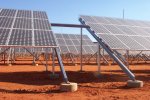| |
 The addition of photovoltaic (PV) modules to a conventional electricity generation system can reduce the long-term cost of energy production, especially in remote locations The addition of photovoltaic (PV) modules to a conventional electricity generation system can reduce the long-term cost of energy production, especially in remote locations
Answers to some frequently asked questions about PV can be found in our PV FAQ file. This includes questions such as:
What is PV?
In short, photovoltaic modules convert solar energy into electricity. There are many ways in which energy is harvested from the sun, whether directly through conversion to electricity or heat, or indirectly through photosynthesis by the use of plant matter. PV modules directly convert sunlight to electricity. Information about other forms of indirect conversion of solar energy to electricity can be found on the Windpower, Solar-Thermal, Biomass and Micro Hydro pages.
PV (photovoltaic) cells or modules are also known as “solar cells” or “solar panels”, though they shouldn’t be confused with solar hot water system collectors that are also often referred to as “solar panels”. The term photovoltaic literally relates to how photovoltaic cells work which is well described in this Wikipedia article.
back to top
How & where can PV be used?
PV cells are usually assembled together in groups, electrically and physically connected to form a PV module. The reason for this grouping is because a single cell only generates a voltage between 0.5 - 0.7 volts and produces a current in the vicinity of one amp. Such a cell producing a maximum of 0.7 watts of power, is too small to be of any practical use by itself. Modern PV modules are capable of producing 50 to 180 watts of power and more. Because power system ratings are most often in the kilowatt range, most PV systems consist of multiple arrays each consisting of multiple modules. Such a modular system is beneficial for installation, servicing and upgrading.
PV modules can be connected together in series or parallel, to meet a wide range of voltage and current requirements. PV systems produce DC power and hence need a conversion device to generate an alternating current if it is to be connected to a mains grid or AC loads. This device is called an inverter. If the PV modules are used as part of a stand-alone system, some form of energy storage is required to meet the short-term difference between energy supply and demand. Stand-alone power systems also require some form of control to regulate power flow. This control is often built into the inverter for smaller systems. Some stand-alone systems utilise only DC electricity, though they are rare.
Some other important points about PV systems include:
- Stand alone power systems (SAPS) are characterised by their simple installation and their delivery of power to where it’s needed, ideal for remote areas. These systems simply comprise electricity generation and a load. Examples of these systems include fans and water pumps run straight off a PV module.
- Adding a battery to a SAPS extends its usefulness to periods when there is little or no sunshine, eg cloudy periods and night time. Applications of these systems extend to powering data logging equipment, sensors and lighting.
- Alternatively a PV module can simply be used to charge a car, truck, boat or caravan battery.
- If a conventional fossil fuelled generation system is already present, integrating a PV system with battery backup will add reliability to the system. The generator only needs to be started when the batteries run low, which means it can be run at full load, greatly increasing efficiency and further reducing fuel consumption. This type of system is known as a hybrid system.
- Grid connection of a PV system allows excess power to be put into the grid and then taken back out when required. This reduces the grid energy consumption while still providing a reliable system (without batteries) that is able to cope with high power demands.
back to top
How do clouds and temperature effect PV modules?
The most common misconception about PV cells is that they need direct, visible sunlight to operate. As the energy of light is proportional to its frequency, higher frequency light such as ultraviolet (UV) light carries most of the useable energy. This higher frequency light penetrates clouds and is invisible to the human eye. PV cells also convert indirect light, such as reflected light. Due to these reasons PV cells still function on overcast days typically producing 50% to 70% of that which they would produce on a clear sunny day.
A fact typically overlooked is that most PV cells lose efficiency as the temperature rises. Common silicon solar cells loose 7-15% of their power output for every 10 degrees Celsius rise in ambient temperature above their nominal temperature which is often specified as 20 or 25 degrees C. This means that PV systems are better suited to climates that are cold and sunny. PV cells based on amorphous silicon are substantially less prone to this effect.
What are the benefits of PV?
PV is a sustainable energy, and so holds all of the benefits described on the sustainable energies page. Additional to this, PV holds some of its own unique advantages, including:
- Can be integrated with buildings and roof-tops.
- No moving parts.
- Silent.
- Low operating and maintenance costs.
- Adequate sunlight present almost everywhere.
- Annual amount of sunlight and hence annual energy highly predictable.
- Efficient land use.
- Modularity.
- Can be portable
- High reliability
- Long life (>20 years)
- Cost effective in remote areas (a 4km rural transmission line costs about the same as a 5 kW PV installation)
- Relative high cost (27-68c/kWh) can be offset by reduction in infrastructure (underground lines, transformers, cost of crossing freeways etc) and reduced operating costs.
Other than the high initial purchase and installation cost, PV has few disadvantages, mainly:
- PV systems don’t function at night and so require energy storage devices
- Inverters are required to run AC devices
- Some production materials used are toxic
- Low energy conversion efficiency
- Cloudy days reduce generation
back to top
Where can I get it?
While Novolta does not retail PV modules or other individual system components, it can provide independent advice and project management for systems above 5 kW. For simple systems less than 5kW, your local system integrator should be able to provide a supply and/or install service.
Detailed product information on specific PV modules can be obtained from the relevant manufacturers: back to top
How much does it cost?
On average, the cost is around $6 - $10 per watt depending on number of modules purchased and the nominal power output of the module. The long-term price of PV modules ought to continue to fall thanks to research and advanced manufacturing techniques. However, recent world-wide shortages have kept module prices fairly steady. This cost is for the panels alone, they then have to be mounted and installed which may need to include energy storage, an inverter, a new switchboard and new cabling. A system that is installed correctly will also adhere to the Australian Standards that cover both stand-alone and grid connected solar power systems. Including a minimum of the above costs, prices would be around $12 - $20 a watt depending on system size, configuration and location.
PV systems are feasible from the top end to the central regions of Australia where sunshine is plentiful. PV systems are ideal for remote area’s where the main power grid doesn’t exist or is several kilometres away.
back to top
What rebates can I get?
The Australian Government provides a number of rebates that are applicable to different types of PV systems. These rebates are subject to changes in legislation. They currently include:
- Photovoltaic Rebate Programme (PVRP))
Managed by the federal Australian Greenhouse Office, this rebate applies to grid connected PV systems.
- Remote Energy Rebate Programme (RERP)
This rebate is a federally funded, but State managed rebate. In the Northern Territory it is managed by the Department of Primary Industries, Fisheries & Mines. The rebate applies to off-grid power systems where the use of renewable energy sources displaces the use of diesel fuel. It applies to technologies other than PV also.
back to top
How long will it last?
A typical PV module is guaranteed by the manufacturer for 20 years or more. Though they can last for longer than this, their power output reduces gradually with age. Some components such as batteries will need to be replaced between 3 and 7 years while others such as electronic regulators and inverters have a serviceable life of about 10 years.
Novolta can assist in optimising system design to get the longest life from expensive components such as batteries.
back to top
Does PV produce more energy over its lifetime than it takes to make?
A common criticism of PV cells is that they produce less energy in their lifetime than the amount it took to make them. While this statement was once arguable, the International Energy Agency now believes that typically energy payback will be realized within three to four years.
back to top
How can Novolta assist me with Photovoltaics?
Novolta can assist with site assessments, energy audits, load profiles and feasibility studies to ascertain wether your site is suitable for a PV system and how much it is likely to cost. Further information on how we can help is located under the Services area of our website.
Further Information
A thorough discussion of photovoltaics in Australia can be found at the Research Institute for Sustainable Energy website.
|
|

